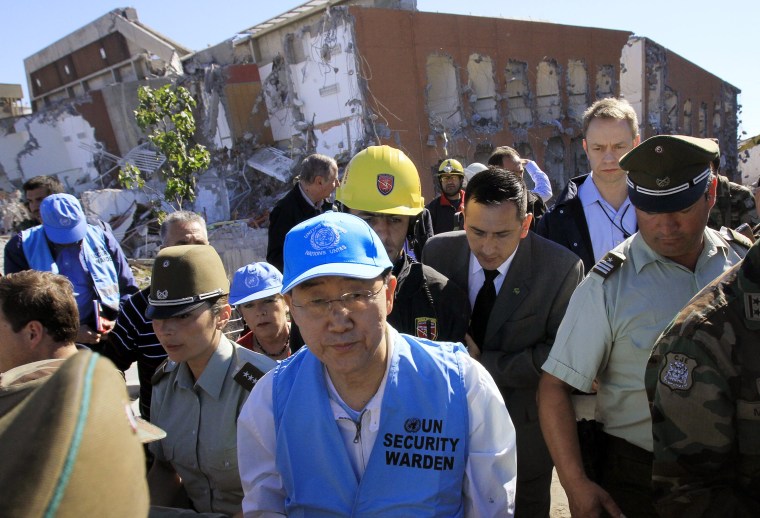Workers demolished a fallen 15-story apartment building that has come to symbolize Chile's earthquake after officials said there was no more hope for finding survivors inside.
The only known remaining victim not recovered from the Alto Rio building was 21-year-old Jose Luis Leon, whose father on Saturday shouted desperately into holes in the concrete cut by rescuers looking for trapped victims.
"Jose Luis! Jose Luis!" cried Jose Leon, who had been given permission by authorities for one last search through the rubble for his son.
There was no answer.
Shortly afterward, a yellow excavator began clawing into the concrete slabs and twisted metal to completely demolish the structure whose collapse during the Feb. 27 earthquake had moved Chileans. U.N. Secretary-General Ban Ki-moon visited the fallen apartment building in the quake-shattered city of Concepcion on Saturday.
"I am convinced that with your bravery and strong determination, you will rise back on your feet again to build a better future," Ban told Chileans.
'Family understands'
Emergency workers said continuing aftershocks have made the rubble too unstable for firefighters to continue looking for Jose Luis Leon and there is no hope of finding more survivors in the Alto Rio building.
"The family understands that there is nothing else the firefighters can do," Cmdr. Juan Carlos Subercaseaux told Chile's Radio Cooperativa, suggesting that the son's body might be recoverable for burial once the demolition is done.
At least seven significant aftershocks shook Chile on Saturday, the largest with a preliminary magnitude of 5.1, according to the U.S. Geological Survey.
No additional damage or injuries were immediately reported, but aftershocks have dangerously weakened buildings all across the disaster zone, including a 22-story office tower whose now-exposed upper floors have partly pancacked and threaten to crash down onto downtown Concepcion. The city's mayor has announced at least five contracts for controlled demolitions of such buildings.
At least 500,000 homes were destroyed, but the figure could reach 1.5 million once surveys are complete, Housing Minister Patricia Poblete said.
At least the Leon family knows the body is somewhere inside the wreckage of the Alto Rio. A week after the 8.8-magnitude earthquake and tsunami, hundreds of people are still searching for relatives with the help of community radio station Bio-Bio, which broadcasts their appeals day and night. With power still out in vast stretches of the disaster area, phone lines downed and cell service spotty, communication was difficult or impossible for most survivors.
Still waitingSome Chileans were still waiting for government aid a week after one of the strongest earthquakes on record and a roaring tsunami killed hundreds and ravaged cities and villages along the South American country's south-central coastline.
Homeless and desperate, survivors voiced anger and frustration at outgoing President Michelle Bachelet's handling of the disaster, saying her administration was too slow to react after the huge quake struck early on Feb. 27.
"There has been an earthquake of disorganization on the part of the national and local governments,'' said Fernando Valenzuela, 44, who is living with his wife in a tent city in the small town of Dichato, near the epicenter.
"This is a case of bad governmental management and organization ... 99 percent of the help we have got has been from the Chilean people, and only 1 percent from the government,'' he added, as others cooked meals over open fires.
The area around Dichato was devastated by the tsunami, which washed large ships as far as 1.2 miles inland. Wooden homes splintered like matchsticks and, a week later, crushed cars still sat at odd angles amid piles of debris.
Cargo planes landed around 19 miles away with water, food and bedding. The government also dispatched two navy ships carrying a combined 120 tons of food and other supplies, but the aid had yet to reach some tent cities.
The government said Saturday basic services such as water and electricity were gradually being restored in disaster areas but acknowledged that the situation was far from normal.
Tons of relief
While many have not seen aid trickle through, U.N. programs already have delivered many tons of relief supplies, including 79 metric tons of high-energy biscuits and other food, enough to feed 35,000 children for five days.
Chileans also are helping themselves: The military is leading a massive relief and recovery effort, with air force planes landing every half hour in Concepcion, and a 24-hour national telethon aimed at collecting $30 million Saturday.
That's just a tiny fraction of the up to $30 billion experts have estimated will be needed for the recovery effort — a huge amount for a country with an annual budget of $42 billion, even though Chile has saved more than $11 billion in copper profits from the state-owned Codelco mining company.
Police flying over the destroyed port in the neighboring city of Talcahuano located another man's body, and divers recovered a boy's body in the coastal town of Pelluhue. In Chile's remote Juan Fernandez islands, where five were killed and 11 swept away in the tsunami, a burial service was held for 14-year-old Maite Arredondo.
With the tsunami wiping away entire communities and stranding wreckage miles inland in mainland Chile, the death toll has been difficult to determine. After first reporting higher figures, the Chilean Interior Department said it would release only the number of identified dead: 452 as of the latest announcement, on Friday.
